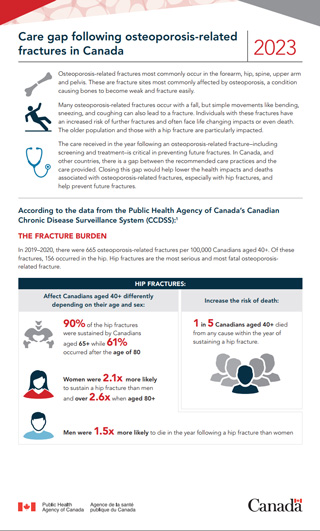Care gap following osteoporosis-related fractures in Canada, 2023
Download in PDF format
(465 KB, 2 pages)
Organization: Public Health Agency of Canada
Published: February 2024
ISBN: 978-0-660-68812-1
Cat.: HP35-149/2023E-PDF
Pub.: 230579
Osteoporosis-related fractures most commonly occur in the forearm, hip, spine, upper arm and pelvis. These are fracture sites most commonly affected by osteoporosis, a condition causing bones to become weak and fracture easily.
Many osteoporosis-related fractures occur with a fall, but simple movements like bending, sneezing, and coughing can also lead to a fracture. Individuals with these fractures have an increased risk of further fractures and often face life changing impacts or even death. The older population and those with a hip fracture are particularly impacted.
The care received in the year following an osteoporosis-related fracture–including screening and treatment–is critical in preventing future fractures. In Canada, and other countries, there is a gap between the recommended care practices and the care provided. Closing this gap would help lower the health impacts and deaths associated with osteoporosis-related fractures, especially with hip fractures, and help prevent future fractures.
According to the data from the Public Health Agency of Canada's Canadian Chronic Disease Surveillance System (CCDSS):Footnote 1
The fracture burden
In 2019–2020, there were 665 osteoporosis-related fractures per 100,000 Canadians aged 40+. Of these fractures, 156 occurred in the hip. Hip fractures are the most serious and most fatal osteoporosis-related fracture.
Hip fractures:
Affect Canadians aged 40+ differently depending on their age and sex:
- 90% of the hip fractures were sustained by Canadians aged 65+ while 61% occurred after the age of 80
- Women were 2.1x more likely to sustain a hip fracture than men and over 2.6x when aged 80+
- Men were 1.5x more likely to die in the year following a hip fracture than women
Increase the risk of death:
- 1 in 5 Canadians aged 40+ died from any cause within the year of sustaining a hip fracture.
The care gap: best practices versus actual care
In an effort to reduce the risk of future fractures, the Canadian clinical practice guidelines on the diagnosis and management of osteoporosis recommend:Footnote 2
- A bone mineral density (BMD) test in adults who had a fragilityFootnote 3 fracture after age 40
- Osteoporosis medication for all adults aged 50+ who have experienced a fragility fracture of the hip or the spine, or more than one fracture
In 2018–2019, the majority of Canadians who sustained any osteoporosis-related fractures did not receive adequate osteoporosis management within the year following their fracture.
- Only 15% aged 40+ had a BMD test
- Only 21% aged 65+ Footnote 4 received a prescription for anti-osteoporosis medication
Among the Canadians who received osteoporosis management care, men were:
- 3.5 times less likely to have a BMD test than women
- 3.5 times less likely to receive osteoporosis medication than women
Know your fracture risk factors
| Type of risk factor | Higher-risk characteristic |
|---|---|
| Sex | Female |
| Age | 50+ |
| Body mass index | Low (under 19 kg/m2) |
| Fractures | Prior fragility fracturesFootnote 3 |
| Family history | Parent had a hip fracture |
| Medication | Prolonged use of glucocorticoids |
| Disease | Rheumatoid arthritis |
| Tobacco use | Current smoker |
| Daily alcohol intake | High (3 or more drinks per day) |
| Bone mineral density measure | Low |
Learn more about the osteoporosis-related fracture care gap
- Visit Canada.ca - Osteoporosis and search 'Osteoporosis and care gap'
- Explore the latest data: Canadian Chronic Disease Surveillance System
- Osteoporosis Canada and Facture Risk Assessment Tool
References and notes
- Footnote 1
-
Public Health Agency of Canada, Canadian Chronic Disease Surveillance System (CCDSS), August 2022. Available from: https://health-infobase.canada.ca/ccdss/data-tool/.
- Footnote 2
-
Papaioannou A, Morin S, Cheung AM, Atkinson S, Brown JP, Feldman S, et al. 2010 clinical practice guidelines for the diagnosis and management of osteoporosis in Canada: summary. CMAJ 2010 Nov; 182(17):1864-73.
- Footnote 3
-
Fragility fractures occur during activities such as reaching, bending, twisting, coughing or sneezing or following a minor trauma such as falling from a standing height or at walking speed.
- Footnote 4
-
The information on osteoporosis medication prescription claims varied extensively across the Canadian provinces and territories and was only available nationally in adults aged 65+.
Acknowledgements
This work was made possible through collaboration between the Public Health Agency of Canada (PHAC) and all Canadian provincial and territorial governments, and expert contribution from the Canadian Chronic Disease Surveillance System Osteoporosis Working Group. This infographic was developed by the Public Health Agency of Canada; no endorsement by the provinces and territories should be inferred.
